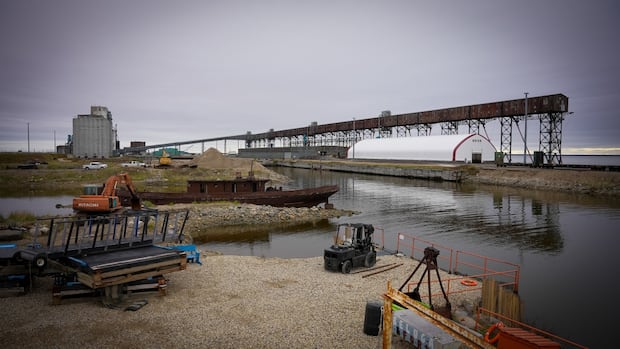Over its lifetime, Churchill, Man., has been many things — a port, a military and defence hub, a research centre and a tourist mecca known as the “polar bear capital of the world” that’s also famous for beluga whale and aurora borealis watching.Now, the only Arctic deepwater port that is connected by rail is being touted as a nation-building project, an outlet for Canadian exports such as LNG and critical minerals and a lifeline for some of Canada’s most remote communities.Locals say they are both excited about the possibility of jobs and population growth, but also worried about how more commercial shipping could impact polar bears and beluga whales and the tourism industry that relies on them.David Daley represents how many long-time residents feel as they wait to hear if Churchill will be named one of Canada’s nation-building projects, bringing with it investment, expansion and increased economic activity.”We hope for better jobs for our kids, better jobs for our grandkids in the future,” said Daley, a Métis sled dog racer, tourism operator and hotel owner in Churchill, about 1,000 kilometres north of Winnipeg and accessible only by air and rail.David Daley, owner of Wapusk Adventures, and his lead sled dog, Rea. Daley has lived in Churchill, Man., his whole life and feels both hope and concern about plans to expand the port and the infrastructure around it. (Karen Pauls/CBC News)”[But] the people that have the tourism relationship here in town, I think that they’re a little apprehensive about like, is this going to be rammed down our throats?”The Port of Churchill Plus proposal would upgrade Canada’s only deep-water Arctic port and rail line and develop export facilities for grain, critical minerals, potash, liquefied natural gas and crude oil. It could include funding for icebreakers, transmission lines to Nunavut, and pipelines — all with the goal of becoming a vital trade link between Canada and emerging Arctic routes to Europe and beyond. Churchill is known as the ‘polar bear capital of the world’ because polar bears gather near the town each fall to wait for the sea ice on Hudson Bay to form so they can hunt seals. (Darren Bernhardt/CBC News)Prime Minister Mark Carney and Rebecca Chartrand, the minister of northern and Arctic affairs and MP for Churchill-Keewatinook Aski, have been cheerleading this project.”Right now we need to get Churchill across the finish line,” Chartrand said in an interview in Ottawa this week.”I think there is absolutely great potential for Churchill to be announced before the Grey Cup,” which is taking place Nov. 16 in Winnipeg.The group that owns the port and railway had already been planning for expansion even before U.S. President Donald Trump launched his trade war. But now, the time seems right to ramp up construction as Canada rethinks its global relationships, said Chris Avery, CEO of the Arctic Gateway Group, a partnership of 29 First Nations and 12 northern communities in Manitoba and Nunavut.WATCH | Arctic Gateway Group CEO talks benefits of Port of Churchill Plus project: How Churchill Plus is being sold to the public Chris Avery, CEO of the Arctic Gateway Group, says the Churchill Plus proposal benefits Canada and Manitoba, as well as the 29 First Nations and 12 northern communities in Manitoba and Nunavut that own the port and railway.”At the Port of Churchill, we’re proud to be able to be part of our national solutions for our national goals, which is to diversify our trade, particularly away from the U.S., to become a global energy superpower, and also to assert our sovereignty in the North,” Avery said on a recent tour of the port.But, he acknowledged, “balance is critical. And it’s not easy.””Back 100 years ago, there was much more volume through the port than there is today and that coexisted very well with the environment as well. So they did it back then. We need to do it in the future.… I fully believe that that can be done.”Mixed feelingsFor Jeremy Allen, of On the Land Adventures, economic development unrelated to tourism is important.”Half the town currently is unemployed, and the reason for that is because the port’s not the booming place that it used to be where the majority of the people in town came up here to work there. And a lot of these families relied on it for their income, and now with nowhere to work people are left in, you know, rough places,” he said.However, he also hopes officials will “do their due diligence” and ensure the economic development doesn’t negatively impact wildlife, like the bears that rely on ice cover for hunting seals.”I think economically it would be great, but environmentally it could turn into a pretty big disaster.”Jeremy Allen, born and raised in Churchill, runs On the Land Adventures. He says there should be jobs in the community for people who don’t want to work in tourism but worries more economic development will hurt his industry. (Jonathan Dupaul/CBC Radio-Canada)Open water almost five months a year on Hudson BayClimate change is forcing the issue, due to a rapid decrease in Canada’s sea ice coverage — a decline of about seven per cent per decade since the 1970s. This loss of sea ice, including the multi-year ice that lasts through summer, creates longer periods of open water, threatening seals and polar bears, and disrupting the livelihoods, travel and safety of Indigenous communities.”From our research, we recognize that the bay as we know it today, it’s going to be very different from the bay that we’re going to see in the foreseeable future,” said Fei Wang, head of the University of Manitoba’s Churchill Marine Observatory. Research shows Hudson Bay has warmed more than 1 C in the last 40 years. Wang says that means every year, there is one more day of open water. In the western part of the bay, the ice-free period is now up to five months, although the port is operational less than four months every year.As head of the Churchill Marine Observatory, Fei Wang and his University of Manitoba colleagues are studying climate change, its effect on the ice, permafrost and animals. They’re developing ways to manage the impacts of increased commercial shipping, including oil spills. (Jonathan Dupaul/CBC Radio-Canada)By 2100, Wang predicts ships will be able to sail from here all the way through the Hudson Strait to the Atlantic Ocean most of the year, without the support of ice-breakers. “The opportunities for social, economic, industrial development is just absolutely unprecedented, but the challenges are enormous.”Wang and his colleagues are studying the effects of climate change on the sea ice, the permafrost underneath the railway, the environment and the animals, but also working on technologies to deal with any of the impacts, for example, an oil spill.”There will be risk, there will [be] impact, and that’s why we need to develop this knowledge to make sure we reduce that impact to the minimum,” he said. Whose voices get heard?Erin Greene owns a stand-up paddle tourism company, taking visitors on the Churchill River amidst thousands of whales during the summer. She worries dredging the river and more commercial shipping will drive them away.”It’s an incredibly special place for them. It is their safety. They come here to give birth. They play here. They eat here. They socialize. This is their home and where they feel safe…. And we’re putting that sense of safety in jeopardy,” she said.Churchill is a prime location for witnessing large populations of curious, playful beluga whales during the summer months as they migrate to the Churchill River estuary. (Darren Bernhardt/CBC News)Greene points to the St. Lawrence River estuary as an example. The belugas there are endangered because of chemical contamination, noise from shipping and construction, reduced food and habitat.”Their entire world is sound. They communicate with sound, they see with sound,” she said. “And when you bring in big ships like that, you completely mask their ability to see.”Greene says she doesn’t think the whales — or most Churchill residents — have a voice in this discussion.She’s trying to understand the economic and strategic reasons to grow the port, but said “it’s very hard for me to care about that when I feel like it will obliterate everything that is special and beautiful about this place.”WATCH | Tourism operators concerned about environmental and economic impact: Environmental and economic concerns for Churchill Plus projectChurchill is known world-wide for its polar bear and beluga whale tourism, and operators like Erin Greene of SUP North worry more commercial shipping will jeopardize it all. Churchill Mayor Mike Spence, who’s also the chair of AGG’s board of directors, says Churchill Plus could eventually generate up to $1 billion in much-needed economic activity — which will stay in the communities.But he knows that brings risks – and responsibilities.”I mean the goal is to find the balance in this,” he said.”As Indigenous people, we’re stewards of the land, you know, where we need to respect what the Creator has asked us to watch over.”WATCH | How climate change is impacting shipping routes: Churchill Port expansion taking advantage of climate changeResearch shows Hudson Bay has warmed more than 1 C in the last 40 years, which means every year, there is one more day of ice-free water, opening potential shipping routes from Churchill through the Hudson Strait, to Europe and beyond. Churchill Mayor Mike Spence says his community can play a crucial role. Key Dates in the Port of Churchill’s History 1920s: The Port of Churchill and railway was built. It was considered a major nation-building project, connecting the Arctic to Canada’s continental rail network through the Hudson Bay Railway. 1931: The port opened for business with the first shipment of grain leaving the harbour. 1931-1933: The terminal grain elevator was completed, becoming the second-largest of its kind in the world at the time. 1997: The port and the associated railway were sold by the Canadian government to a private American company, Omnitrax. 2012: The Harper government eliminated the Canadian Wheat Board’s monopoly, allowing farmers to market their grain freely. This eventually led to the shutdown of the port’s grain operations in 2016. 2017: Flooding washed out the Hudson Bay Railway, leading to a legal dispute between Ottawa and the railway’s owner, Omnitrax, which escalated into lawsuits filed by both sides 2018: The federal government stepped in to facilitate the railway’s purchase and transfer to a new private-public partnership called OneNorth and Fairfax Financial Holdings Ltd. Fairfax left the partnership two years later 2020 to present: The port and rail line have undergone significant upgrades and modernization by the ownership group, now known as Arctic Gateway Group.
Friday, 26 Dec 2025
Canada – The Illusion
Search
Have an existing account?
Sign In
© 2022 Foxiz News Network. Ruby Design Company. All Rights Reserved.
You May also Like
- More News:
- history
- Standing Bear Network
- John Gonzalez
- ᐊᔭᐦᑊ ayahp — It happened
- Creation
- Beneath the Water
- Olympic gold medal
- Jim Thorpe
- type O blood
- the bringer of life
- Raven
- Wás’agi
- NoiseCat
- 'Sugarcane'
- The rivers still sing
- ᑲᓂᐸᐏᐟ ᒪᐢᑿ
- ᐅᑳᐤ okâw — We remember
- ᐊᓂᓈᐯᐃᐧᐣ aninâpêwin — Truth
- This is what it means to be human.
- Nokoma











